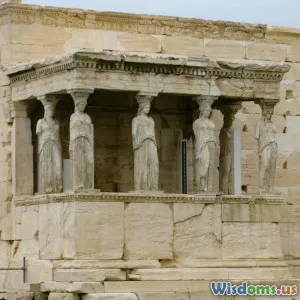
Lost Colors of Greek Sculpture How Ancient Artists Painted Stone
8 min read Discover how vibrant colors once adorned Greek sculptures, revealing lost artistry beneath the white marble. (0 Reviews)
The Lost Colors of Greek Sculpture: How Ancient Artists Painted Stone
Introduction
When picturing ancient Greek sculpture, visitors often imagine pristine white marble statues standing silently in museums and archaeological sites across the world. This timeless whiteness has been the defining aesthetic for centuries — but did you know that this is far from the original appearance? Ancient Greek sculptures were not blank canvases but dazzling, vibrantly colored masterpieces. The lost colors of Greek sculpture reveal a startling reality: those serene marbles were once bursting with hues that conveyed status, symbolism, and narrative meaning. This article delves deep into the fascinating world of polychromy, the ancient art of painting stone, illuminating how Greek sculptors crafted more than just shapes — they created color-infused stories.
The Misconception of White Marble
White Marble: An 18th-Century Imagination
The myth of monochrome Greek statues largely stems from the Renaissance and Neoclassical eras when artists and scholars admired the bare marble’s subtle beauty. Excavations revealed statues weathered and eroded by centuries, bleach-washed by sun and rain, stripping away any remaining pigment. Historically, this erosion gave rise to the idealized notion that classical sculpture was deliberately colorless, a pure form of artistic expression emphasizing form over decoration.
However, Tomb studies, classical texts, and, more recently, advanced scientific techniques have exposed how inaccurate this whitewashed vision is. Ancient viewers saw these statues wrapped in vibrant robes of color, faces tinted, hair finely detailed in reds, blacks, and golds — a full chromatic experience.
The Art and Science of Ancient Polychromy
Why Paint Stone?
Marble provided a highly durable blank surface which enhanced the brightness and durability of pigments. Coloring wasn’t used just for aesthetics — it reinforced narratives and cultural messaging. For example, gods could be distinguished via specific colors symbolizing their divine attributes, while the colors in clothing marked social ranks or story contexts.
Pigments and Materials
Ancient Greek artists used a naturally sourced palette. Common pigments included:
- Red ochre (hematite) for lips, hair, and garment details.
- Yellow ochre for elements ranging from hair highlights to fabric patterns.
- Malachite and azurite for vibrant greens and blues.
- Carbon black for outlines and details, often from charcoal or soot.
- White derived from crushed chalk or lime for highlights.
Binders such as beeswax or egg tempera helped pigments adhere to stone.
Application Techniques
Artists approached coloration carefully, painting in layers to ensure longevity. They applied translucent washes to let marble’s texture augment the colors’ brilliance, or opaque coatings where vivid color was desired. Features such as eyes were accentuated with finely painted eyelashes and pupils, giving sculptures a lifelike gaze—the finest artistry combining plastic form with chromatic detail.
Unearthing the Colors: Modern Discoveries
New Technologies Reveal Ancient Hues
The use of ultraviolet (UV) light, X-ray fluorescence (XRF), and multispectral imaging has revolutionized our understanding of polychromy. These non-invasive methods detect microscopic pigment particles trapped within marble pores invisible to the naked eye.
A notable example is the statue of the ancient Greek kore (maiden) figures, such as the "Peplos Kore" from the Acropolis, where careful analysis confirmed the original red-orange cloak and blue accents.
Case Studies
- The Villa of the Papyri in Herculaneum showcased painted bronzes preserved by volcanic ash, where intricate patterning and bright colors were identified.
- The Francois Vase vase and sculptural ensembles like the Temple of Aphaia statues retain traces of polychromy patterns, indicating a widespread Greek practice.
Scholarship and Reconstruction Efforts
Conservators and historians, like Dr. Vinzenz Brinkmann of the Liebieghaus Sculpture Collection, have combined archaeological evidence with digital restorations, producing vivid reconstructions that challenge centuries of monochrome assumption.
These projects stir public imagination and move museums towards presenting Greek art as authentically as possible.
Cultural and Artistic Implications
Color as Storytelling and Symbolism
Colors coded deities, heroes, and mortals distinctly. Red could indicate vitality or violence, while gold or blue suggested divinity. This symbolic interplay gave viewers nuanced understanding beyond sculpted form.
Redefining Classical Aesthetics
Acknowledging polychromy forces us to re-evaluate classical art theories heavily focused on form purity. It opens conversations about Greek art reflecting dynamic multi-sensory experiences comparable to modern multimedia.
Influence Beyond Greek Lands
The practice spread to Roman sculptures and influenced Byzantine mosaics, emphasizing continuity and innovation in ancient artistic traditions.
Conclusion: Rediscovering Ancient Vibrancy
The "lost colors" of Greek sculpture invite us to see antiquity with refreshed eyes. Through the merging of scientific inquiry, art historical scholarship, and technology, we reclaim the vibrant expressions our ancestors intended and challenge engrained notions of classical beauty. These revelations enrich our cultural heritage and inspire both awe and humility.
As museums explore polychrome presentations and virtual reality enables immersive journeys into the past, the once silent white marbles speak in newfound tones, painting history with strokes of color that time nearly forgot.
In rediscovering the hues on stone, we rediscover lost voices of Greek antiquity — nuanced, vivid, and profoundly human.
References:
- Brinkmann, Vinzenz, and Ute Wartenberg. The Color of the Gods: Polychromy in Greek Sculpture. Liebieghaus Collection, 2008.
- Seiter, Ellen. "Polychromy in Ancient Greek Sculpture," Journal of Archaeological Science, vol. 39, no. 3, 2012.
- Cagnat, Léon (ed.). "Ancient Techniques of Painting." Bulletin de Correspondance Hellénique, 1921.
- The Acropolis Museum, Athens: Scientific reports on kore polychromy, 2015.
- Wrapped in Color: The Lost Polychromy of Ancient Greece. National Geographic, 2019.
Explore the brilliance beneath the marble and unlock the ancient palette that once adorned human forms in stone.
Rate the Post
User Reviews
Popular Posts



















